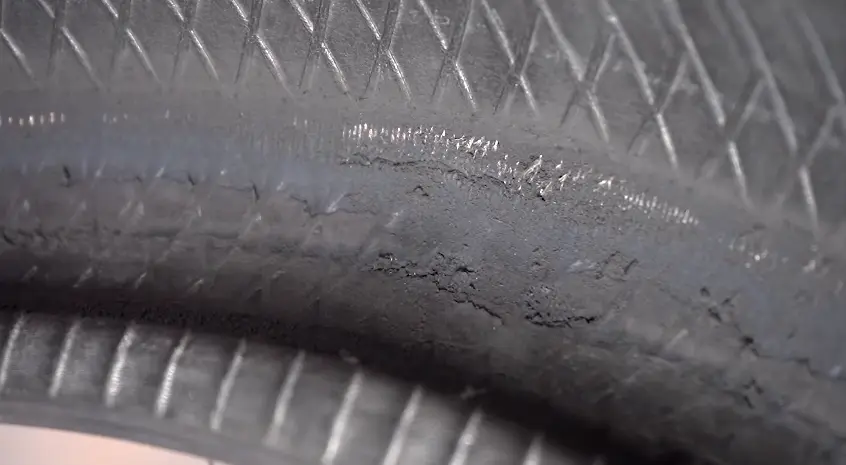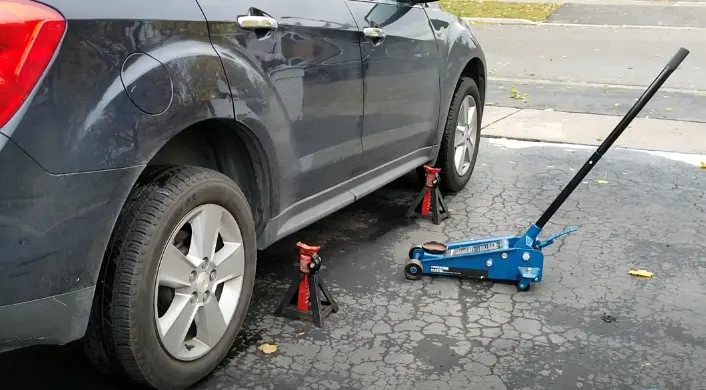How Close To Sidewall Can A Tire Be Patched
As per the US National Highway Traffic Safety Administration (NHTSA), in 2020, 664 individuals died on the road in car accidents due to bad tires.
Unprofessionally patched tire is one of the common causes of tire failure, most of the time, a puncture near the sidewalls or on the edge of the shoulders.
Each puncture can’t be repaired, particularly the sidewalls and shoulders are irreparable areas of a tire, but most drivers are unknown of this fact. So, every driver should know how close to sidewall can a tire be patched to avoid tire failures.
If the puncture is 6mm away from the sidewall, then you can patch it, but if it’s less than 6 mm, then you should avoid patching such type of risky puncture and replace this tire with a new one. Read on to know more details.
How Close To The Sidewall Can A Tire Be Patched?
If you are going to patch your tire close to the sidewall below 6 mm, the patch will probably not be successful because it’s too close to the sidewall.
You can’t successfully patch the tire such close to the sidewall puncture, and you only have one option, which is to replace this damaged tire.

Also, if the punctured hole is larger than ¼ inches, then it’s useless to patch it. You may patch it, but the tire will deflate after the car starts moving because the sidewalls are responsible for absorbing jerks to provide ride comfort.
The closer you patch your tire to the sidewalls, the more lethal your tire is to get a blowout. If you get a puncture on the sidewall, then it’s crucial to inspect the sidewalls from the inside to know about the damage to the internal structure of the sidewalls.

How Do You Avoid Getting A Puncture?
To be honest, there is no guaranteed method to avoid punctures, but there are some helpful tips. By following, you can minimize the chances of getting a puncture.
These are scheduled tire rotation, monitoring tire pressure regularly, avoiding potholes and road hazards, avoiding overspeeding and overloading, and scheduled tire checkups. Let’s discuss this in detail.

Scheduled Tire Rotation
Scheduled tire rotation normally after every 7000 to 8000 miles, and alignment helps a lot to avoid getting a puncture. Tire rotation keeps tires worn equally and avoids uneven tire wear.
Uneven tire wear significantly increases the chance of getting a puncture because the tire tread wears out faster, resulting in reducing the tread depth.
Monitoring Tire Pressure Regularly
To get optimal tire performance, correct tire pressure is a crucial factor to maintain. Too much tire pressure or too low both can cause a tire to puncture or blowout.
Overinflated tires can cause a puncture because excessive air inside the tire increases rigidity, and the tire will not give way after hitting an object. Likewise, tires with lower pressure can cause sidewall punctures.

So it’s important to check and maintain recommended tire pressure regularly after every 2 weeks to get maximum tire life and to avoid puncture.
You can view recommended tire pressure for your vehicle from the owner’s manual or a sticker on the driver’s side door jamb.
Avoid Potholes And Road Hazard
It may seem like a simple task to avoid debris or portholes while driving, but there are some nuances to consider.
Most of the time, you may be unable to see the smaller debris littered with the shoulders and gutters of highways and roads from the driver’s seat. You can reduce the risk of getting punctured by avoiding these road hazards and potholes.
Avoid Overloading Or Overspeeding
Overloading tires can increase the risk of getting a puncture, the same as increasing tire pressure. You can check the max tire load limit listed on the sidewall of the tire.
Also, it would be best to avoid overspeeding on uneven roads to reduce the chances of experiencing a puncture.
Scheduled Tire Checkup
Scheduled tire checkup is crucial to minimize the risk of a tire puncture. A tire specialist will examine your tires to detect early symptoms of tire wear, including cracks and bulges on the tread or sidewalls.
What Type of Damage To a Tire Can and Cannot Be Repaired?
Not all tire damage can be repaired, and it’s important to know what kind of damage can be fixed and what cannot. Here are some general guidelines:
Repairable Damage:
- Puncture hole that is less than 1/4 inch in diameter on the tire tread.
- Cuts or punctures on the sidewall that are less than 1 inch long and not too close to the tire bead.
- Punctures after driving on a flat tire with no indications of damage to the sidewall.
Non-Repairable Damage:
- Punctures that cover more than 1/4 inch area.
- Severe damage to the sidewall or tread resulting in bulges, long cuts, cracks or bubbles.
- Tires that have been driven on while flat or underinflated clearly indicate severe sidewall damage, especially from inside the tire.
- Any puncture or damage that has caused the sidewall cords or wires on the tire tread to be exposed.
- If the remaining tread depth on your tire is 2/32″ or less, in that case, you should replace your tire.
Is It Safe To Drive With A Gash In The Sidewall Of Tire?
No, driving with a gash in the tire sidewall is unsafe. A gash in the sidewall can compromise the tire’s structural integrity, leading to a blowout or other dangerous situations while driving. It’s important to replace the damaged tire with a new one.
Can You Get A Nail In The Side Of Your Tire?
Yes, getting a nail on the sidewalls of your tire is possible. The sidewall of a tire is more vulnerable to damage than the tread area because it’s thinner and more flexible.
If you run over a nail or any other sharp object, it penetrates the sidewall and can cause a puncture.
How Long Can You Drive On A Patched Tire?
You can drive on a patched tire as long as the patch installation works well. More than 4 months ago, I repaired a hole in my rear left tire using a plug.
Last month, it developed a minor leak that requires topping up with air approximately once a week. Finally, yesterday I replaced this shit with a new one.
So, it depends on the puncture’s size and location, the patch’s quality, and how well the tire was repaired.
What is Tire Patch or Tire Plug?
Both methods are used to repair punctures in the tire. A tire patch is a long procedure to repair the tire and a glued rubber patch is applied to the puncture hole from the inner surface of the tire.
Whereas a tire plug is a quick method to repair the tire. A plug made of rubber or latex is inserted into the puncture hole without removing tire from the rim.
The tire plug is considered an emergency or temporary repair, while the tire patch is more reliable than the tire plug.
Conclusion
I discussed in detail how close to sidewall can a tire be patched in this article. Once again, the short answer is if it’s 6mm away from the sidewall.
Also, you can read details about tire damages that can or can not be repaired. Replacing a damaged or punctured tire with a new one is the safer option, and it is definitely something you will do eventually, as I have done.
Well, It’s your money, or it’s your life. In these situations, taking a risk is not advisable. Have a safe drive!






